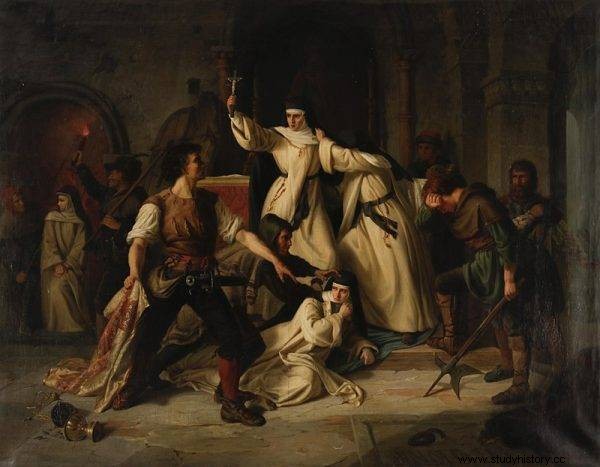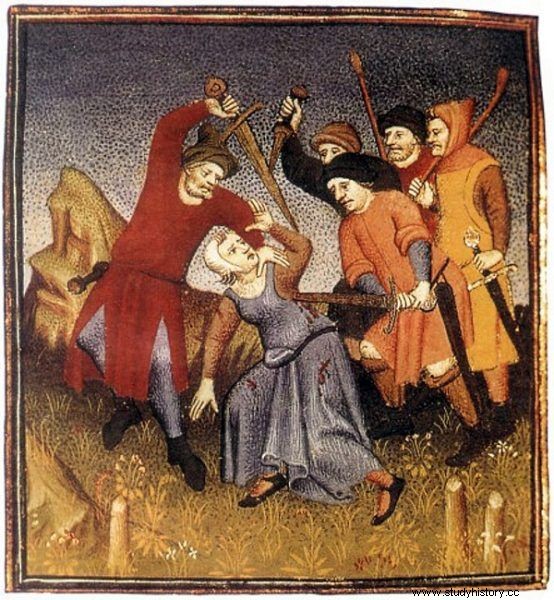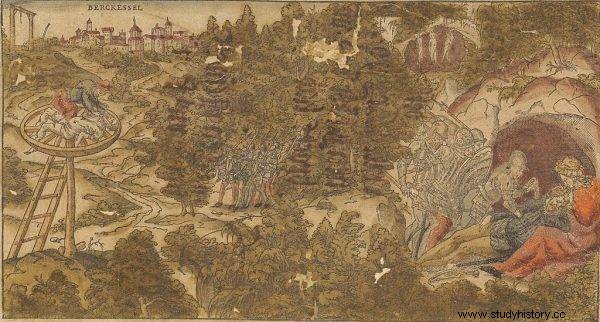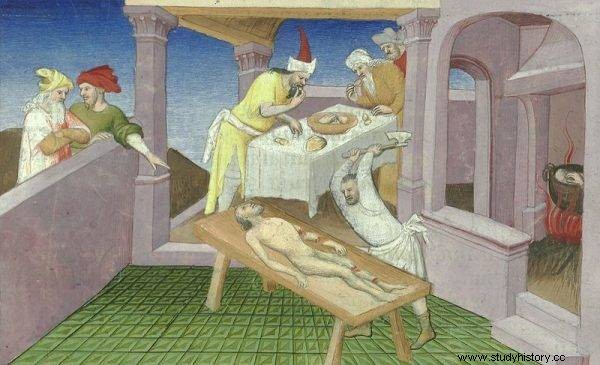More than 500 people were said to have been killed by Peter Niers. He dabbled in black magic, murdered babies and ate their hearts. But how much truth is there in this story?
History is full of cruel rulers and ruthless killers who didn't care about human life. Some of them did indeed commit terrible crimes. However, many characters, described as real monsters, have been largely exaggerated. Their misdeeds have been greatly exaggerated. Examples include novels about Vlad the Impaler, Elżbieta Bathory or Sawney Bean mixing the truth with fiction. It was similar with the infamous highwayman and murderer Peter Niers. Was he a flesh and blood figure? Or is it a legend that was haunted by merchants traveling across Europe?
Peaceful village, cheerful village
If at least half of the deeds attributed to Niers were true, then would be one of the greatest murderers ever to roam Europe . The kind of man he has become, however, is in part the fault of the difficult times in which he lived. Born in Germany in the mid-16th century, the son of a simple peasant, he grew up in the shadow of enormous social unrest in Central Europe. The ideas of reformation spreading across the continent mobilized masses of suffering feudal exploitation of peasants to take up the fight to improve their fortune.

The local uprisings that broke out from time to time eventually turned into a great peasant war in 1524
The local uprisings that broke out from time to time eventually turned in 1524 into the great peasant war that consumed southern Germany until 1526 . Armies of rebellious peasants led by local leaders (such as Thomas Müntzer) stormed the estates of wealthy landowners, monasteries and cities. When the riots were suppressed, repressed villagers joined the gangs of robbers roaming the area.
Central Europe became a place where rape, terror and anarchy spread. In Germany alone, the preserved records show that at the end of the 16th century, murders accounted for as much as 15 percent of all committed crimes . Divided into many lesser principalities, the Holy Roman Empire was the perfect environment for all kinds of looters and thieves. Local authorities were unable to cope with the growing problem of bandits wandering from place to place. One of them was Peter Niers.
Land of highwaymen
Before Niers entered the path of crime, a certain German shepherd, Martin Stier, had formed a gang of nearly fifty people with his colleagues. The Stiera Company has been prowling for over 22 years in an area that stretches from southern France to the Netherlands. Executed for his actions in 1572 Stier became an inspiration for Niers, who around 1566 decided to create his own gang.
Initially, it numbered about twenty highwaymen and spread terror in the countryside of Alsace. The Niersa Gang quickly grew in strength and expanded its area of operation. Bandits traveled hundreds of miles, stealing and murdering. They were active in western France, as well as in the Rhineland and Bavaria. The gang later changed their modus operandi. It split into several groups and attacked more smaller targets. From time to time, however, highwaymen had the courage and freely entered the cities to murder, rape and rob their inhabitants.

The Stiera Company has been prowling in an area stretching from southern France to the Netherlands for over 22 years.
Rumors about the cruel bandit Peter Niers began to circulate around Europe. Travelers traversing the continent prayed not to fall victim to it. Happiness has favored the highwaymen for eleven years. In 1577 they were finally betrayed by one of their companions . A large part of the gang with its leader were captured. Niersa was tortured, during which he confessed to committing 75 murders. However, he soon managed to escape from prison and avoid the inevitable execution. Due to the bandit's escape, his notoriety increased even further.
The devil incarnate
After 1577, the figure of Niers began to take more and more fantastic shapes. He was depicted as a robber with crooked fingers and a scar on his chin. It is said that he always had a lot of money with him, two pistols and a sword. In the 1579 arrest warrant, he was described as "rather old." In books devoted to him he was also accused of cannibalism and possessing various supernatural powers .
The best chronicler of Niers's "career" was a man named Johann Wick, who produced three different pamphlets describing his misdeeds. In them he reported that near Phalsbourg in France, a bandit had made a pact with the devil to train him in the art of black magic . According to rumors, in order to be able to become invisible, Niers made special candles from the skins and fat of the fruit. It was said that he cut off the hands and feet of infants and then ate their hearts . He was also said to enjoy eating the breasts of young girls. During his escape, Niers could turn into a log, stone, or wild animal. Possibly he dressed up as a leper or a soldier. The magical abilities attributed to him did not prevent him from being captured again. The bandit career of the robber finally ended in 1581.
Like life, such death
Niers was captured in the town of Neumarkt. According to the chronicles, he left his leather bag with a local innkeeper and then went to the bathhouse. Local residents were well aware of who had visited their settlement. While Niers was enjoying his bath, his luggage was opened. The dry hearts and hands of small children were to be inside. Niers was arrested and tortured. Confessed to 544 murders. More than twenty of his victims were to be pregnant women .

Niers was not the only murderer in the 16th century in Germany. Genipperteing's Christman - like Peter - was executed by breaking the wheel
In view of such crimes, the bandit could not count on a quick and painless death at the hands of the executioner. In September 1581, a crowd of people went out to the streets of the city to observe the suffering of the criminal. At first, his body was skinned and hot oil was poured into the wounds . On the second day of torture, Niers' feet were smeared with oil and baked in hot coals. Finally - on the third day of the ordeal - the bandit was broken with a wheel . To the surprise of the onlookers watching the executions, Niers was still alive after all these "manipulations". This was seen as a devilish help. Quarrels with Satan, however, did not save the robber. His execution was completed by the executioner, cutting off all his limbs.
Truth or myth?
A man subjected to elaborate torture is prone to confess to anything. The number of over half a thousand victims of Niers is therefore rather unrealistic. On the other hand, it is known that a highwayman named Peter Niers existed and acted for real. There is evidence of this in the form of records from the chronicles of German cities. The whole "devilish" part of the story about him is, however, the result of the belief of the then society in superstition. Germany in the 16th century was a land of witch hunts and witch trials. The influence of the devil was the best and simplest explanation for the cruel acts committed by humans. Fantastic stories about Peter Niers fit perfectly into this pattern.

Peter Niers was accused, inter alia, of for cannibalism
Or perhaps his story is actually a jumble of biographies from several different characters . At that time, apart from the aforementioned Stier, there were at least two equally murderous bandits in Germany - Christman Genipperteing and Peter Stumpp. The former was to murder even more people than Niers, as many as 964. Both gentlemen are also connected by the fact that they both ended their lives broken on the wheel. Stumpp, in turn, was considered a child-eating werewolf who, like Niers, made a pact with the devil.
We will probably never find out the whole truth about the history of the infamous bandit. What can be read from the stories of his terrible practices is largely a projection of the unrest that disrupted the life of European society in the Reformation era.
